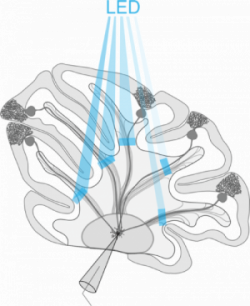We are pleased to share recent work from Kim Gruver, a recipient of the Mightex Annual Research Award, 2021, and Mightex Student Travel Award for presetnign her work at the Canadian Association for Neuroscience (CAN) meeting in Toronto (May, 2022). Kim’s doctoral work combines patterned illumination from the Mightex Polygon with a motorized stage to dissect the functional connectivity of the cerebellar microcircuit.
Kim Gruver

PhD Candidate, McGill University, Canada
Kim is a PhD student in the Integrated Program in Neuroscience at McGill university. She is supervised by Dr. Allana Watt. Kim recently received a Mightex Annual Research Excellence Award as well as a Travel Award for her research outlined below. We look forward to continuing to support Kim’s research in the future and to see this exciting project progress!

Kim uses the Mightex Polygon to study functional connectivity within the cerebellar microcircuit. To do so, she performs electrophysiology experiments on acute brain slices from mice that transgenically express the light-sensitive cation channel ChR2 in Purkinje cells to evaluate patterns of connectivity between Purkinje cells and cerebellar nuclei neurons. The Polygon allows us to sequentially stimulate different cerebellar lobules in quick succession to assess the presence of a functional connection. With these data we are characterizing how different kinds of information are integrated within the cerebellum, and how these patterns may be implicated in behavior.
Image 1. Schematic of patterned photostimulation of the cerebellar microcircuit using the Mightex Polygon.
Kim has integrated the Polygon with a motorized stage on her electrophysiology rig, a customized Scientifica SliceScope Pro 3000 microscope. She is then able to generate patterns from the Mightex Polygon that are projected onto her sample, allowing her to accurately stimulate regions of interest located in different areas across an acute slice from a mouse cerebellum. By returning to preset regions after each trial using her motorized stage, she can sequentially stimulate areas that do not share a field of view under a 40x objective. This means she can simultaneously record from neurons and stimulate their presynaptic inputs located across the acute slice.
Below you can see a video of Kim’s experimental set up in action.
Video 1. Patterned Illumination and Motorized Stage of Scientifica SliceScope Pro 3000; Video Courtesy of Kim Gruver and Watt Lab, McGill
Learn More
Interested in using the Mightex Polygon in your own research? Check out our Polygon product page:
Learn About the PolygonContact Us
"*" indicates required fields



